3-10 March 2014. The word galápago is an Old Spanish word for tortoise. The Galápagos Islands were named by the Spanish explorers who discovered them in the 16th century. We are visiting the islands of tortoises, the biggest tortoises in the world, and we get to spend time with them on two occasions. We go to the breeding centre on San Cristobal Island. We see baby tortoises as small as five centimetres long, and we see adolescents about a metre long. The babies, dozens of them, are in incubators. The older ones roam the grounds in their slow lumbering way. They are unconcerned about our presence.
Giant Tortoises are the world’s longest-living vertebrates, living an average of 100 years. They are also the biggest tortoises in the world, reaching up to 1.5 metres in length and weighing up to 250 kg. As many as 250,000 were killed during the 17th to 19th centuries for meat and oil, but now, thanks largely to an intensive breeding program, their numbers have increased greatly, and ten of the fifteen species that existed in Darwin’s time still remain. The shape of the shells varies from island to island, each species having adapted to the local climate and terrain. Darwin found this a compelling example that helped lead to the development of his theory of evolution.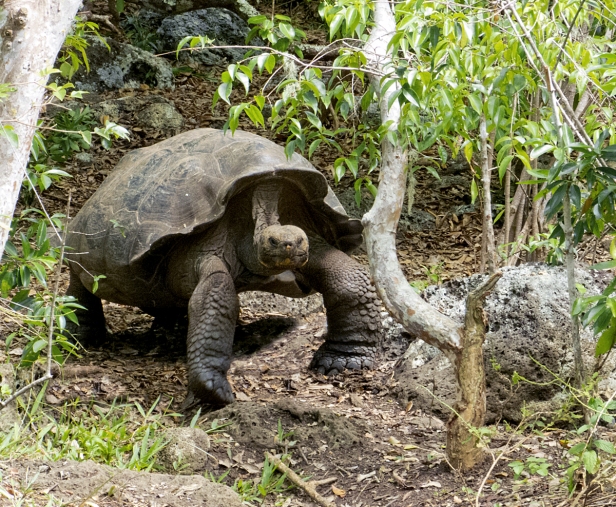

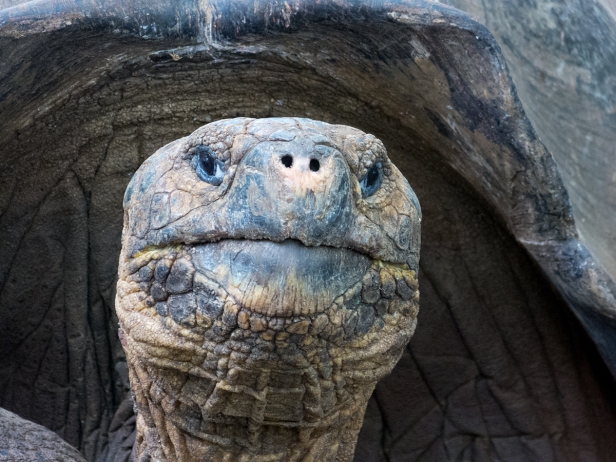
A few days later we go to the highlands of Santa Cruz Island where we see a different species in their natural forested environment.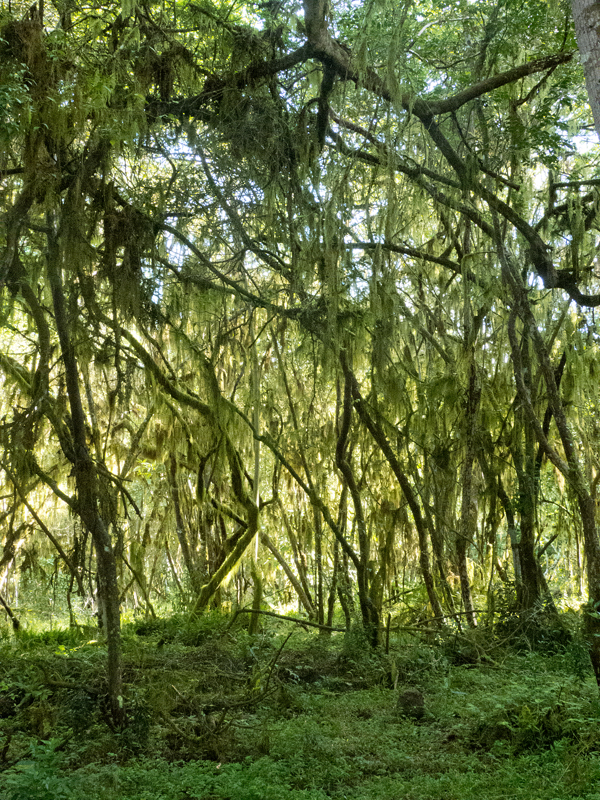
Male tortoises, like the males of most species, fight for dominance. Whoever has the longest neck wins. Seriously. We watch an alpha male move through the green slime of the pond to challenge another. Slowly. What’s the rush? That other guy isn’t going anywhere. When he gets close he lifts his head up as high as it will go. The other tortoise responds by lifting his head, slowly, deliberately. There they rest, both with their heads raised high in the air.
No need to be rushing anything. After a while, at a sedate and leisurely pace, they both pull their heads back in. 
Then after a little breather, and a goodly rest, up their heads go again.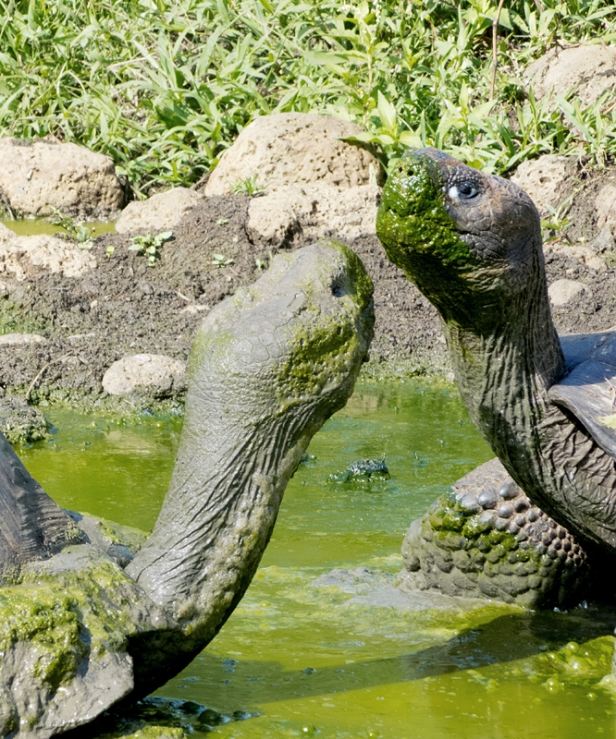
You can see who’s going to win here but the one that’s being challenged doesn’t budge; he likes that spot in the pond. So the big guy stretches out his neck and lifts his head up again, as high as it will go. The other tortoise responds. Then slowly back down again. Up again. Down again. It took about ten minutes and about four or five neck stretches. Finally the smaller tortoise admits defeat, and carefully placing one huge elephantine foot in front of the other, lumbers away through the pond scum. Such excitement.
The head of the Galapagos Giant Tortoise was used as the model for the head of the heart-melting alien in the movie ET.
On the second day of our Galapagos cruise, on South Plaza Island, we see Blue-footed Boobies. It is a moment of exultation and we high five in delight. Blue-footed Boobies are one of the unique birds of the Galapagos and we’d watched Youtube videos of their mating dance in which they lift their bright blue feet one after the other, as high as they can. It’s truly comical. Blue feet are an indicator of good health thus are a survival advantage. The mating dance is mostly about the feet, the bluer the better. We didn’t get to see the mating dance, but seeing the birds was gratifying enough. After that first encounter we saw them many times in several different locations.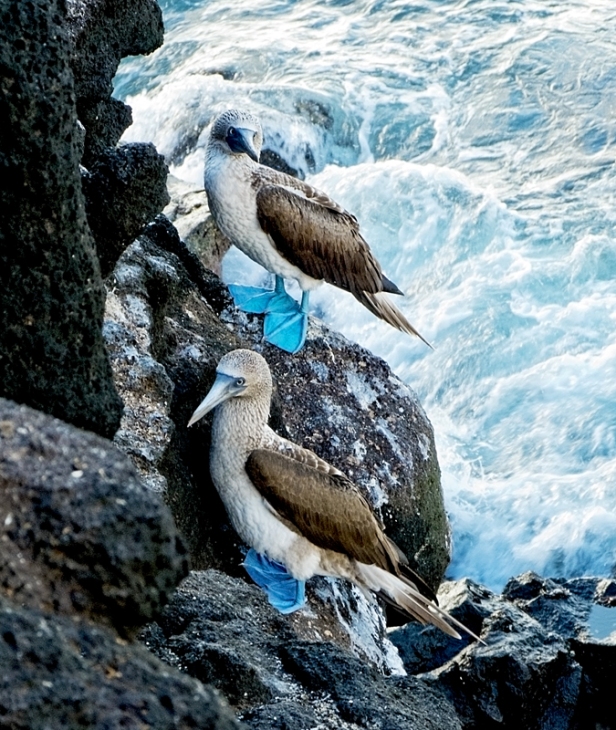

Frigate birds swarm above the ship almost continually hoping for scraps of food. They are superb flyers, and fight in the air to steal food from each other. They were named, for their thieving ways, after pirate warships.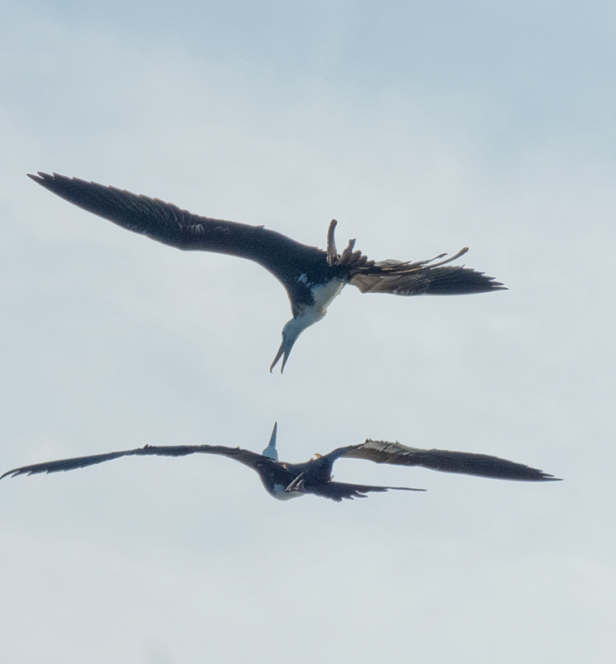
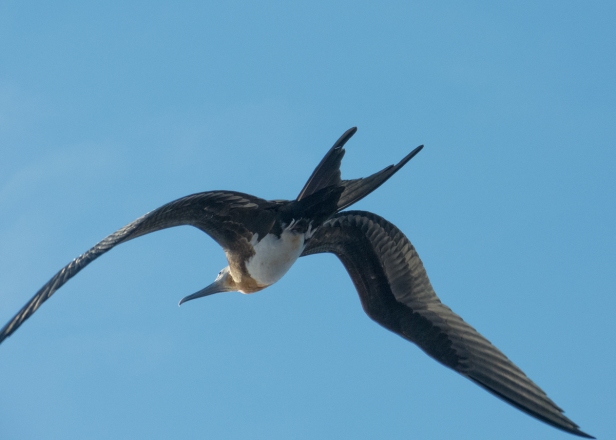
This one is a Great Frigate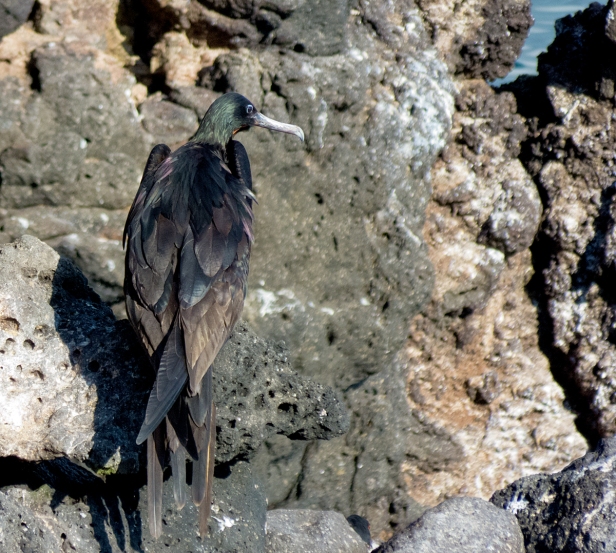
and these are nesting Magnificent Frigates.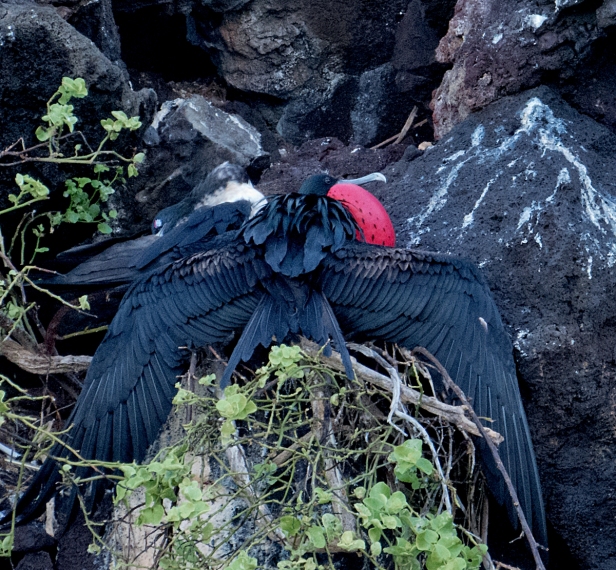
I think they’re both great. And definitely magnificent. The red pouch on the male is inflated as part of their courting ritual. Hey! Over here! Look at me!
Swallowtail Gulls are everywhere,
and we frequently see elegant Blue Herons.

Drifting along in the dinghy, close to shore we watch a heron. I take several photos, waiting and waiting for more movement. Then I catch it just as it’s picking up speed for take off.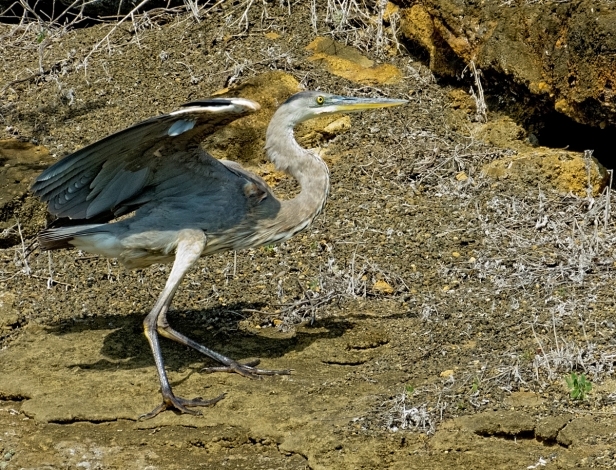
Not quite so elegant, and definitely more comical is the Galapagos Heron. I take many photos of this particular bird as it hops around on the rocks. I have a full-body profile shot that would be a far better illustration of it, but this shot is much more amusing.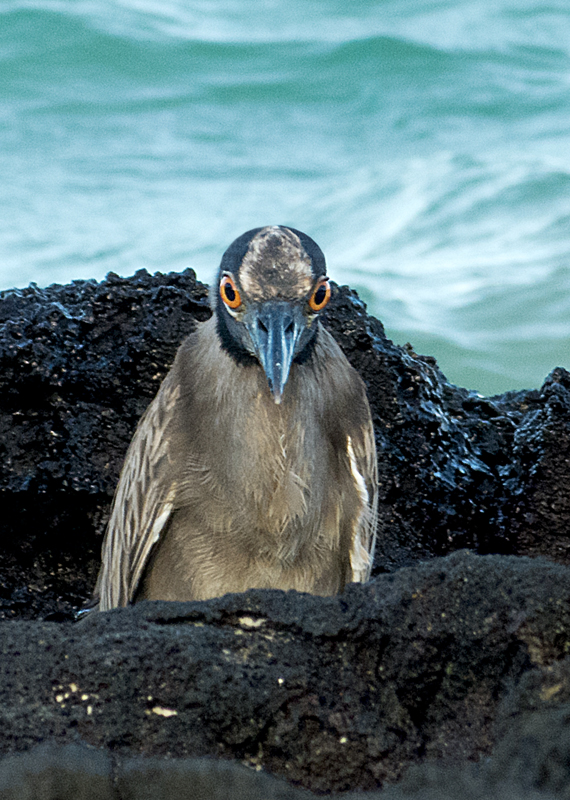
We often see Galapagos Brown Pelicans. They’re ungainly birds, clumsy on land and ponderous in flight, nevertheless they have a droll beauty with that enormous pouched beak. Even though I‘ve seen pelicans many times before I still find them exotic.
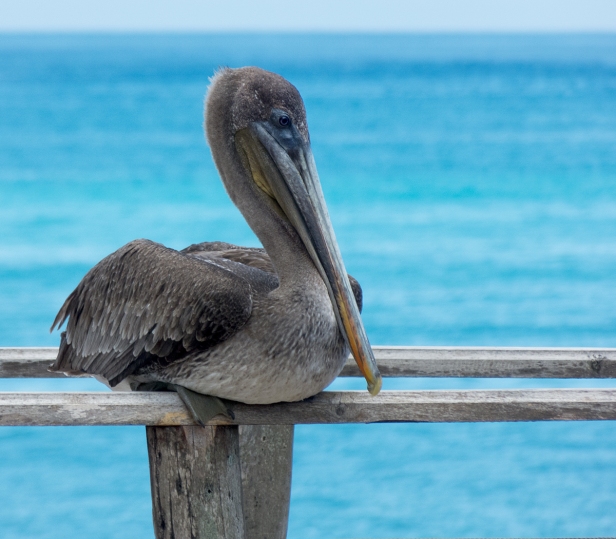
After a long hike on Española Island we come to a colony of nesting Nazca Boobies. Wow wow wow, boobies as far as you can see; all over the cliff top and right up to the edge of the path. Hundreds of them. Probably thousands. It would be only a slight exaggeration to say we have to be careful not to walk on them. It’s busy, a continuous commotion as adult birds come and go with food for the fluffy chicks. Like all the wildlife of the Galapagos, they are unconcerned about our intrusion into their world.
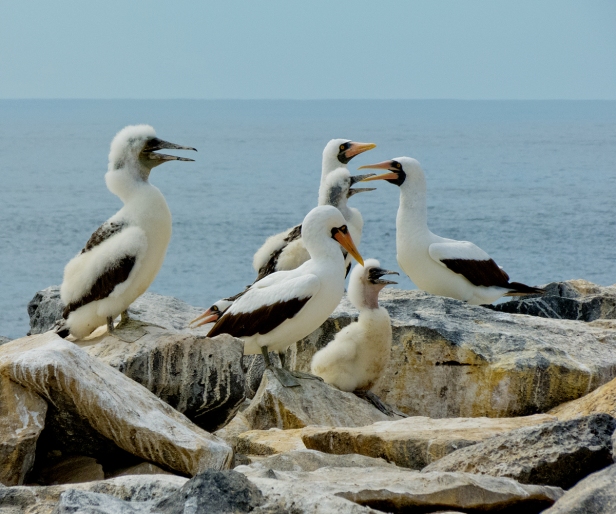
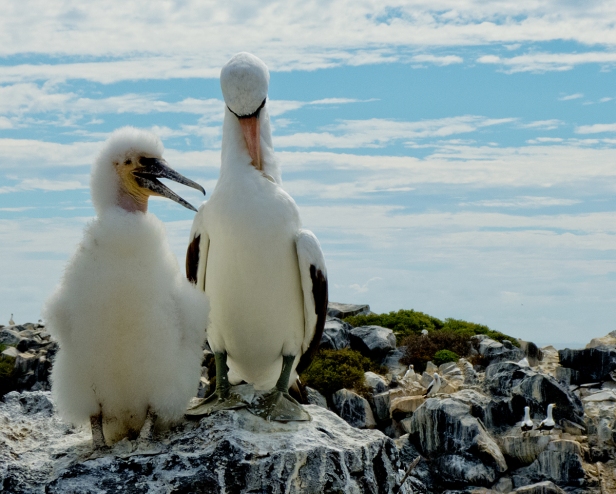
Further along the cliff we come to a blowhole that shoots water 23 metres into the air. Spectacular!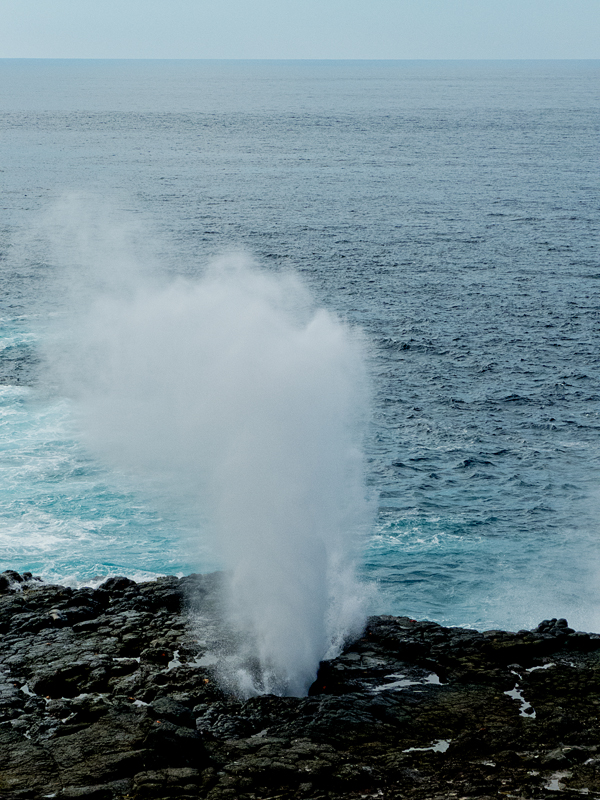
On another day, after a long hot hike over dry rocky terrain we see a Red-footed Booby on the cliff. Later we come to the edge of another cliff, and looking down we see more Red-footed Boobies nesting in the trees.
The beautiful Galapagos Dove,
and a Yellow Warbler.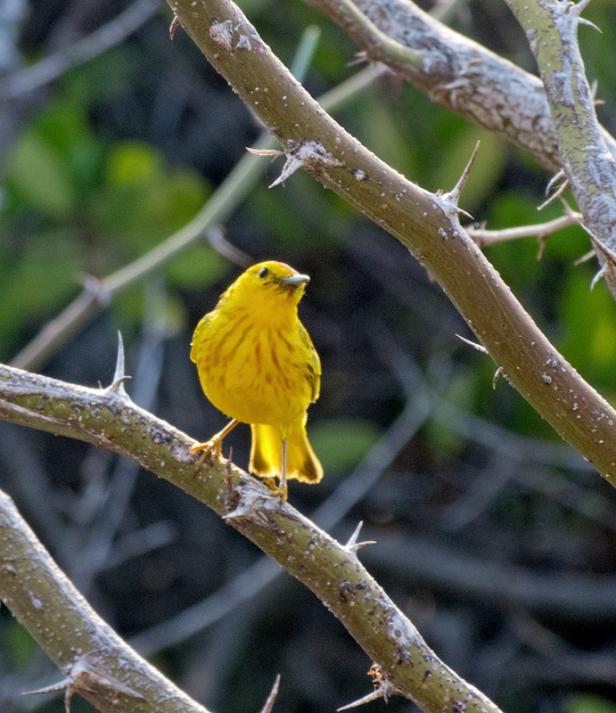
Oh the glorious warm crystal clear water. Almost daily we are swimming and snorkeling.
One day we’re scattered all up and down a beach and in the water. I am snorkeling alone a little way off shore, heading for a nearby islet hoping to see the fish that gather around the underwater rocks. Instead, about half way there I meet a turtle. For a few serene joyous minutes I swim with the turtle, keeping it in sight, then losing it, then finding it again, in a watery game of hide and seek.
On at least two different beaches we see turtle tracks and nests.
During various snorkeling expeditions we see stingrays, large Angelfish and many other varieties of tropical fish, Reef Sharks and White-tipped Sharks.
On one occasion the guide dives deep to encourage two White-tipped Sharks to leave their hiding place under a ledge. Out they come, taking off in opposite directions. And one day we see dolphins and follow them for a while in the dinghy but they are too fast for us. Oh I wish I were back there right now, swimming in the warm clear sea soaking up the enchanted beauty of that underwater world.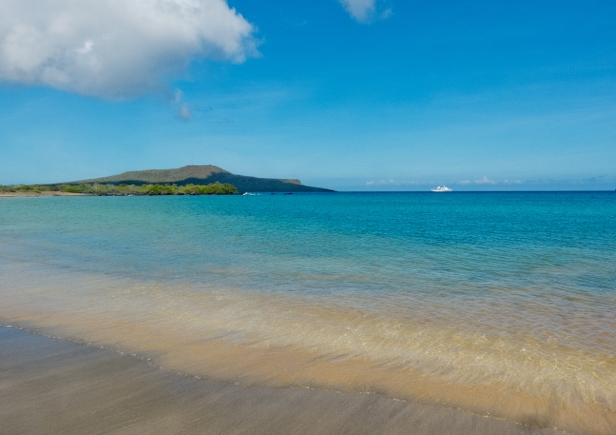
On Floreana Island you can leave a postcard in a barrel to be, hopefully, collected and hand-delivered by someone going to the place it’s addressed to. You can also collect and deliver those postcards addressed to your destinations after Galapagos. It’s the continuation of a tradition started by the whaling ships back in the 1800’s before the existence of international postal delivery. I collected a postcard for delivery to Canberra, Australia since I’ll be there later this year. Can’t wait to see the look on the person’s face when I show up at their door with a postcard from Galapagos, probably left months or years ago by a friend or family member who has long-since returned home.
The sea lions of the Galapagos know no bounds. Anywhere they can find some shade is fine by them, including here in the town of Puerto Baquerizo Moreno on San Cristobal. Conservemos lo nuestro! Preserve what’s ours indeed.
After eight days our Galapagos adventure came to an end. It was one of the great highlights of our travels in South America, and one of the best things we’ve ever done. It was an extraordinary magical time and we feel immensely blessed that we were able to go there. If you ever have a chance go! There really is nowhere like it.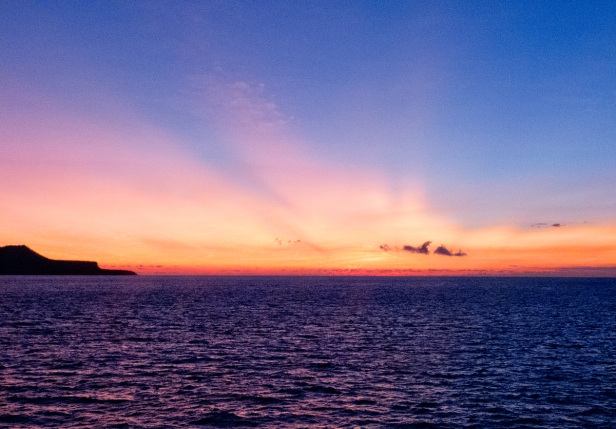
Our ship was the Galapagos Legend, run by Klein Tours
http://www.galapagos.org/about_galapagos/tortoises/
http://video.nationalgeographic.com/video/ecuador_galapagos?source=relatedvideo
Next post: The beautiful colonial town of Cuenca, Ecuador
All words and images by Alison Louise Armstrong unless otherwise noted
© Alison Louise Armstrong and Adventures in Wonderland – a pilgrimage of the heart, 2010-2015.

Fabulous photos!
LikeLike
Thanks Angeline.
LikeLike
Splendid shots…
What a great variety of birds!
Thanks a lot for sharing 🙂
LikeLike
Thanks Sreejith. The birds were amazing. This isn’t even all of them. A species of albatross nests there, but not until about a month after we were there. Apparently it’s like the boobies nesting – thousands of them.
Alison
LikeLike
The turtles look very wise…
LikeLike
They do don’t they. Maybe it’s their years of experience 🙂
A.
LikeLike
This has made my morning. Such wonderful nature! I loved hearing about the sparring turtles. I also loved the postcard delivery idea – all the best with your travels 🌎🌍🌏
LikeLike
Thank you so much Susan, I’m glad you liked it. It was fascinating to watch the turtles’ face-off. Slow, but interesting. We were waiting and waiting to see the outcome. Finally the little guy got the message.
Hope you’re having/had a good time in Straya!
Alison
LikeLike
I love reading your blog and today’s entry was really a “keeper.” What company arranged your tour? Was it a cruise? I’d like to know for the day I have a chance to go to Galapagos. Happy trails!
Libbie
LikeLike
Thanks so much Libbie, glad you enjoyed it. I’ll just copy/paste the info I put in a comment in the previous Galapagos post:
The ship is Galapagos Legend, run by Klein Tours. I was going to put a link to their website but it appears to have been hacked by something Russian. Hopefully they will discover it soon and fix the problem.
We paid just over $4000 each (which included return airfare from Quito) and booked through http://www.galapagosislands.com
If you google Klein Tours you’ll get a link to their website, but I’m not sure I’d recommend it. It went to something Russian and I had to shut down the computer. Other than that it doesn’t seem to have done any harm. Fingers crossed. galapagosislands.com is fine and offers many alternatives for tours of the islands.
Happy trails to you too. Hope you get to Galapagos!
Alison
LikeLike
I enjoyed your fascinating description of the two male tortoises battling it out. Your photos are amazing. Thanks.
LikeLike
Thanks so much Frank. The turtles were wonderful. So unexpected to see that little battle – a slice of turtle-action!
Alison
LikeLike
Sitting here in England on a Sunday morning yet transported to these wonderful locations – what a way to start the day; and I’m still on my first mug of tea.
Beautifully depicted and highly informative; quite outstanding.
With much gratitude and respect, and wishing you both safe travels.
Hariod Brawn.
P.S. If only we humans would settle our conflicts in the manner of the tortoises . . .
LikeLike
Thank you so much Hariod. I’m glad I brought a little exotica into your Sunday morning. I can just about taste that mug of tea.
Wouldn’t it be wonderful if all that was needed was a little neck stretching to settle conflicts. Still that would mean that the biggest always wins and I’m not sure I agree with that idea 🙂
Alison
LikeLike
Ohh I really miss this place… you have captured so many wonderful moments on your pictures… I am amazed!
LikeLike
Thanks so much Alliane. Like you, I’d love to go back too – there’s so much more to see. Still, I’m so grateful I got to go even once. It’s a magical place.
LikeLike
Yes!! And Im sure you made a lot of beautiful memories, I can tell by the amazing pictures 🙂
LikeLike
What a beautifully written post and amazing photographs!! What an exciting trip!
LikeLike
Thanks so much Michelle. Yes, it really was an exciting trip. The Galapagos is such a special place.
LikeLike
Reading through this was like watching a wonderful nature documentary, Alison! Loved the humour too; I chuckled at the sea lion napping on the bench and the oh-so-slow challenge of the giant tortoises. As usual your bird photos were stunning – especially those handsome blue-footed boobies. Were the Nazca boobies oblivious to the human presence when you went? I wonder if we humans should take a note from the bird world… it seems to be the male putting in the most effort to attract a mate, not the other way round!
LikeLike
A nature doc! Wow, thanks James. Isn’t that sea lion on the bench great?! Preserve what’s ours!
Yes, the Nazca boobies were oblivious, and I agree re taking a note from the bird world. I suspect there’s a lot of women would benefit from having a more laissez faire attitude 🙂
Alison
LikeLike
The Galapagos Islands are truly some of the planet’s most magical places. Not only Darwin who was inspired by its sheer diversity, maybe we can also learn something from the wildlife there. Take the giant tortoise. Who knows if we fight like them where all we need to do is raise our heads, we might live longer. 🙂 Comical is another word to describe Galapagos, I suppose.
LikeLike
I think we can certainly learn from the wildlife. You’ve given me a different way to see it. I’d replied to Hariod that I didn’t like the idea of the biggest always winning. But maybe we could see it more as those who are willing to step forward and lead, just by lifting their heads, would be the ‘winners’ and then we could all win since everyone is not predisposed to be a leader.
I don’t think Galapagos is comical, but some of the wildlife is 🙂
Alison
LikeLike
Wonderful photos. Really terrific. Absolutely love these. ❤
LikeLike
Thanks so much Paulette. It’s an extraordinary place. We are still swooning.
A.
LikeLike
Hi Alison and Don,
enjoyed your post about the Galapagos Island. It is now on our “bucket list”!
Your entry came just two days after I saw this video. You might enjoy it, too.
Tanya
http://www.huffingtonpost.com/2014/07/14/diver-saves-sea-turtle_n_5574705.html
LikeLike
Thanks Tanya. What a great video – Ioved that there was a diver there to help the turtle, though I do think the ‘thank you’ was probably more to do with flipper paralysis. Still, a very sweet moment.
Alison
LikeLike
remarkable!!
LikeLike
Thanks Cindy. Definitely a remarkable place!
Alison
LikeLike
I love the picture of the sea lion just lazily lounging on across the seat…under the conservation sign/ Cute but very stinky I’m sure
LikeLike
I took that sea lion picture because I was tickled by its choice of resting place. I’m sure it lurched itself back into the water eventually. They are surprisingly good climbers. It was only later that I understood the significance of the writing on the bench. Not stinky!
Alison
LikeLike
What manner of bird was that yellow-vested one rising out of the water like Poseidon? A Frigate? A Heron? Oh, sorry, must be Don.
LikeLike
Ha ha 🙂 Before I got to the end of the sentence I was wondering – what yellow-breasted bird, I didn’t post any picture of a yellow breasted bird’ lol.
A.
LikeLike
Well, I knew the “Don Bird” wasn’t one of the Booby lot, because you didn’t photograph his feet. Which left the Frigate, Heron or maybe Pelican. Seriously, great to see ALL the species in such accord with the elements.
LikeLike
It’s a good thing I’m not a tortoise – I’d never win a neck-stretching contest in my life. 🙂
Funnily enough, out of all the amazing things in this post, the one that strikes me the most is the postcard barrel. What an amazing adventure, to just show up on someone’s doorstep with a postcard written months, or years, before.
Since it will be some time before I can afford to go there, that gives me a lot of time to compose the perfect postcard.
LikeLike
Oh I’m so glad you liked the postcard barrel. It’s a bit touristy – after all it’s only tourists that go there – but it arose from a genuine circumstance and has been kept alive through the years. I almost didn’t write about it, but then decided I couldn’t leave it out.
LikeLike
Awesome Pictures!
LikeLike
Thank you so much.
(I just retrieved your comment from the spam file 😦 )
LikeLike
I want to go here so badly!
LikeLike
I hope you get to go one day – it’s a really special place.
Alison
LikeLike
What gorgeous images, Alison. I especially liked the second one of the Blue-footed Boobie. And this is a wonderful tradition:
“On Floreana Island you can leave a postcard in a barrel to be, hopefully, collected and hand-delivered by someone going to the place it’s addressed to. You can also collect and deliver those postcards addressed to your destinations after Galapagos.”
Lovely post. As always.
Heart,
Dani
LikeLike
Thank you so much Dani. The blue-footed boobies are so unusual. Whoever would have thought of a bird with big blue webbed feet!
We all liked the postcard stop, and diligently looked through the cards. I think our small group of about 15 took 3 or 4 cards to deliver. That’s a pretty good average.
Alison ❤
LikeLike
Wow, this is truly a stunning place to explore. Those pictures of the sky are just electric – pure perfection.
I love the blue footed boobies, how unusual and beautiful. All of the birds you saw were incredible. Cruising along with the dolphins must have been amazing.
It almost seems like an entirely different world, what an incredible experience! Made me want to drop everything and go right now.
~ Andrea ❤
LikeLike
Isn’t it amazing?! We were just enraptured every day – with the birds, the animals, the sea, the sky. It’s a very special place, so do go if you ever get the chance.
Alison
LikeLike
You two never fail to amuse and educate plus provide great photos. Thanks for the tour of the Galapagos Islands. The blue footed boobies were truly special and I always love the turtles. I was so intent on following one in Hawaii once I placed myself right in front of a moving boat. LOL The pilot had a few choice words for me. 🙂 Curt
LikeLike
Thanks Curt. We loved the Galapagos. It’s an astonishing place; such richness of wildlife and scenic beauty. Oy that boat pilot must have been cursing you lol. But so much fun to follow the turtles eh?!
LikeLike
That turtle had me. LOL I would have followed it anywhere.
LikeLike
The photography!!!!!! The mystic aura…the Boobies!! The blog! Hats off guys! 🙂
LikeLike
Thank you so much. I’m so glad you’re enjoying it. Those boobies are truly wonderful aren’t they?!
Alison
LikeLike
oh yes they are ❤ 😀
LikeLike
Where it must have been a great experience with the wildlife.
LikeLike
Yes, thanks, Pia. An amazing experience with the wildlife. I don’t think we’ll ever forget it.
Alison
LikeLike
I can understand that. Ha, a great day.
LikeLike
Gorgeous photos and lovely post. This was to me the first time when I saw a post from the Galapagos. Thank You.
LikeLike
Thank you so much. And you’re welcome. The Galapagos Islands are one of nature’s treasures and I’m glad to be able to share it’s beauty.
LikeLike
Another dazzling collection of images! Species I never heard of in such living colors.
I am thinking about those turtles and their slow-motion stiff neck competition, and the crazy way they have the presence of mind to let the measurements dictate the day’s champion. It reminds me of a conclusion I once came to, that is undoubtedly not true in every case, that the competitions that establish the pecking order in any given species are seldom settled by actually “playing the game”. They’re settled by plumage and color, displays of virility, or a few exploratory head butts and an extrapolation to the end game. I tend to root for under-dogs because it’s exciting when they play with unexpected brilliance or determination. But these turtles don’t actually play the game, they have a proxy for the real thing… an agreement… “it’s best for both of us, and gives our species the highest chance of success, if the long-necked among us thrive.”
The logic embedded in Nature is always incredible to me. We’ll undoubtedly find– or someone has already found– an evolutionary advantage to having a long neck, but for species who live a hundred years and move at a snail’s pace, how much advantage could there be? We’d never admit it, but it might just be a long-standing gentleman’s agreement… A cultural thing… They seem like they’re cool-headed like that… 🙂
Michael
LikeLike
This seems to me to be the way it is – some kind of gentleman’s agreement, throughout most species. As you say there’s an extrapolation to the end game which makes more sense that actually killing off the weaker, though undoubtedly that happens too in some species. My theory is the longer the neck, the bigger the tortoise, and that there’s some advantage to being big. I don’t know if all species of Galapagos tortoise establish dominance in this way, though our guide seemed to imply that. I do know that on the islands that are dryer and often have no ground- cover meaning the tortoises have to stretch up to get food (as opposed to wetter, forested, and having ground cover) the tortoises have shells that have a V indentation where their necks stretch up allowing for greater ease of movement, and the ability to stretch higher. Galapagos has many micro climates. That’s amazing to me in such a small area. I suppose I should have written about that. Each micro climate of course dictates the vegetation and thus the unique characteristics of the birds and animals of that island.
I think the tortoises are far too slow to be anything but cool-headed 🙂
I too an slack-jawed and thrilled at the logic in nature. It is continually a mirror for us, and a great pity that many seem not to get the message.
Alison
LikeLike
Oh my! I have to show my husband this post. He loves the huge Galapagos turtles.
We stood and watched the Galapagos turtles at the Honolulu Zoo, even though none of them were moving. Then, after about 15 minutes, one of them raised its head, stood up, and then laid back down. My husband whispered, “Wow…did you see that? The turtle moved!”
LikeLike
Yes, they’re just like you described – so slow, or unmoving. They’re actually tortoises. (The marine ones are turtles, are much faster,comparatively, and especially when in water).
LikeLike
Sigh! Your wonderland is truly inspirational. Every frame captures the varied life forms of Galapagos.
LikeLike
Thank you so much. I’m glad you’ve enjoyed this little visit to Galapagos. I hope one day you will have your own adventure there!
Alison
LikeLiked by 1 person